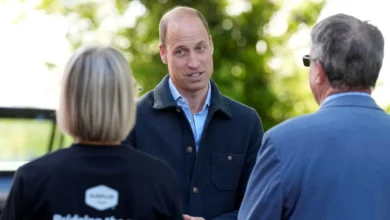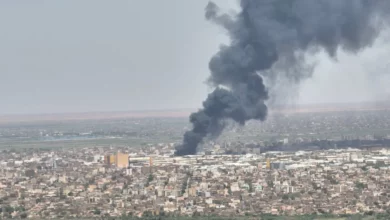
PARIS (AP) — An Islamic State operative went on trial Monday in Paris on terror charges for swaggering bare-chested through a train in 2015 with an arsenal of weapons and shooting one passenger. He was brought down by three American vacationers in an electrifying capture that Clint Eastwood turned into a Hollywood thriller.
The scene five years ago on the fast train from Amsterdam to Paris is the focus of the month-long trial of Ayoub El Khazzani, with testimony expected from the two US servicemen and their friend, who have been hailed as heroes.
With El Khazzani in court and watched by security officers, the trial opening Monday was largely taken up with procedural issues including whether Eastwood’s presence is needed. That question was not immediately resolved. The actor-director has so far not responded to a summons. Eastwood turned Aug. 21, 2015, drama in car No. 12 into a movie “The 15:17 to Paris.”
El Khazzani, a 31-year-old Moroccan, spent several months in Syria and boarded the train in Brussels armed to the hilt, authorities say. He is charged with attempted terrorist murder for the foiled attack. If convicted, he faces a maximum sentence of life in prison.
Three others, who weren’t on the train, also are being tried for their roles as alleged accomplices.
Bilal Chatra, 24, an Algerian member of the Islamic State group, would have been the second man on the train but dropped out of the plot a week earlier. He had left Syria for Europe a week before to set up the exit route.
Mohamed Bakkali allegedly took in the Europe-bound attackers in Budapest, Hungary, which he denies. The two were arrested in Germany in 2016. A third man, Redouane El Amrani Ezzerrifi, allegedly piloted a boat to help in their return to Europe.
The trial serves as a bridge to the massacre of 130 people in Paris three months later, on Nov. 13, 2015, at the Bataclan music hall and restaurants and cafes. The man considered the likely mastermind of those attacks, Abdel Hamid Abaaoud, was the behind-the-scenes force in the train attack, planned in Syria, according to the prosecution.
Abaaoud traveled from Syria to Belgium with El Khazzani to organize attacks in Europe, and was holed up with him and Chatra in a Brussels apartment, according to the prosecution. Abaaoud was killed by French special forces days after the Bataclan attack. But before his death, his macabre organizational skills were at work in a failed plan to attack a church south of Paris in April 2015 that left a young woman dead. Sid Ahmed Ghlam was convicted earlier this month and sentenced to life in prison.
The train attacker, El Khazzani, “knowingly followed Abaaoud, but it’s been years since he was in a jihadi mindset,” his lawyer, Sarah Mauger-Poliak, said in a phone interview. “He is very affected and regrets having allowed himself to become indoctrinated in propaganda.”
The propaganda evolved into a plot to allegedly kill trapped passengers.
El Khazzani bought a train ticket at the Brussels station on Aug. 21, 2015 for a 5:13 p.m. departure. He was armed with a Kalashnikov, nine clips with 30 rounds each, an automatic pistol and a cutter, according to investigators.
Once on the train, he lingered in a restroom between cars and emerged bare-chested with a Kalashnikov. One waiting passenger struggled with the attacker, then a French-American, Mark Magoolian, wrestled the Kalashnikov away — before being shot himself by a pistol as he headed to car No. 12 to warn his wife. Magoolian said in interviews later that the attacker recovered the Kalashnikov.
Spencer Stone, a then-23-year-old US airman, said days after the attack that he was coming out of a deep sleep when the gunman appeared. Alek Skarlatos, then a 22-year-old US National Guardsman recently back from Afghanistan, “just hit me on the shoulder and said ‘Let’s go.’”
The three men, all from California, snapped into action out of what Skarlatos said at a news conference days later was “gut instinct.” Stone and Skarlatos moved in to tackle the gunman and take his gun. The third friend, Anthony Sadler, 23, then a student, helped subdue the assailant. Stone said he choked El Khazzani unconscious. A British businessman then joined in the fray.
Stone, whose hand was injured by the cutter, is also credited with saving the French-American teacher whose neck was squirting blood. Stone said he “just stuck two of my fingers in his hole and found what I thought to be the artery, pushed down and the bleeding stopped.”
The train rerouted to Arras, in northern France, where El Khazzani was arrested.
El-Khazzani had left Morocco at age 18 to join his family in Spain. In 2012, he established links with radicals. He went to Brussels before heading to Turkey, a gateway to Syria. A watch list signal “sounded” on May 10, 2015, in Berlin, where El-Khazzani was flying to Turkey, then-French Interior Minister Bernard Cazeneuve had said.
El Khazzani told investigators that Abaaoud wanted him to kill only the American military men, a line he was likely to maintain during the trial. The investigating judges consider it a dubious claim, in part because their presence in the train couldn’t be known in advance and they were in civilian clothes.
That defense also fails to jibe with Abaaoud’s goal of killing a maximum number of people during attacks.
___
Nicolas Vaux-Montagny reported from Lyon, France.
Image: Lawyer of Islamic State operative Ayoub El Khazzaniin, Sarah Mauger-Poliak, arrives on the opening day of the Thalys attack trial, at the Paris courthouse, Monday, Nov. 16, 2020. El Khazzani goes on trial Monday Nov. 16, 2020, in France on terror charges for appearing on a train with an arsenal of weapons and shooting one passenger in 2015. (AP Photo/Thibault Camus)




